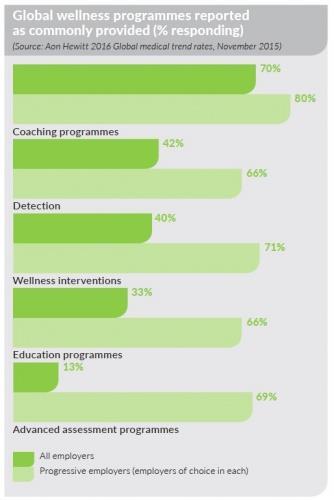
Need to know:
- Local differences including state healthcare provision, insurance regulations and culture will affect how a global health and wellbeing strategy is applied in different countries.
- As well as improving employee health, global wellbeing challenges can encourage greater teamwork and underline the organisation’s commitment to its workforce.
- Language differences and regional events should be taken into account when arranging global wellbeing programmes.
Looking after employees’ health across a global workforce can present a number of challenges. As well as ensuring a consistent approach, any benefits and initiatives need to be relevant to employees to ensure they are valued and engaging.
Most international firms will have a global strategy but allow local regions to bespoke this, says Matthew Lawrence, head of broking and health and risk proposition at Aon Employee Benefits. “The key health and wellbeing issues – cardiovascular health, cancer, diabetes and mental health – are the same everywhere but, when you come down to a country level, differences such as healthcare provision, regulation and culture will affect what an organisation can offer its employees,” he explains.
For example, while a UK employee is used to seeing their GP for free, cross the sea to the Republic of Ireland and an appointment will cost €50 plus. Similarly, countries such as the Netherlands, France and many of the countries in the Middle East have mandatory health insurance, which will need to be taken into consideration when designing benefits.
Local approach to healthcare
These differences in healthcare provision make a one-size-fits-all approach impossible for a global organisation. The rules and regulations in each country must be reflected when putting together a global package, says Damian Lenihan, sales director at Aetna International. “An organisation may still be able to negotiate terms on a global basis to take advantage of economies of scale, but it’s essential to involve local teams in the benefit design,” he adds.
Culture will also affect what an employer offers on a local level. Although globalisation has helped to remove some of the differences between nationalities, there are still some important things to look out for when it comes to health. For instance, while Western medicine is the norm in North America and Europe, travel to the Far East and an employee may be more likely to be offered traditional Chinese medicine such as herbal medicine and acupuncture.
Differences can be more subtle too. Sarah Dennis, head of international at The Health Insurance Group, says: “In the UK, a GP would tell [an individual] to take a couple of paracetamol if [they] had a cold; in the US they would send [the person] for tests to check it wasn’t another condition. These differences need to be reflected in any health and wellbeing information and benefits [an employer] provides.”
But, while local differences can still affect what is provided, technology is making it easier to take a global approach with some health and wellbeing initiatives. The internet, apps and wearables can easily override any cultural or language issues.
Global wellbeing
Running a wellbeing challenge across a global workforce has a number of benefits above and beyond improving employee health. The Global Corporate Challenge, for example, pits teams of seven against one another to walk the furthest distance in 100 days. Emily Sowden, European marketing manager at the Global Corporate Challenge, explains: “Offering a wellbeing initiative to a global community of employees can foster teamwork across an organisation, as well as highlighting the organisation’s commitment to its employees and their health. This can have a huge impact on engagement and productivity.”
But, while it is becoming easier to take a global approach to wellbeing, to get the most from these initiatives, the local approach is still important. For example, using the local language can drive up participation rates. It is also prudent to be mindful of any regional events that might affect employees taking part. For example, in 2015 GCC launched an event in September to suit employees in the southern hemisphere.
And technology is set to play an even larger role in organisations’ healthcare strategies, says Lawrence. “Technology is available now that can track [an employee’s] health and alert [them] if something changes that could indicate a problem,” he explains. “It’s baby steps at the moment but it could potentially become part of an organisation’s approach to looking after the health and wellbeing of its employees.”

Zurich takes a country-specific approach to staff health and wellbeing
Global insurer Zurich employs around 55,000 people in more than 170 countries. Although it has a global strategy to create an environment where employees feel their health and wellbeing is supported by the organisation, the delivery of this is very much determined by the specifics of each country.
Georgina Farrell, head of UK HR at Zurich, says this local focus is essential. Before taking up her role in the UK, she worked in HR for Zurich in Asia and the Middle East. “Cultural differences mean it’s impossible to have a one-size-fits-all approach. For example, in the UK the average length of service is 13 years, whereas in the Middle East it’s around half this, so [it] needs a much less rigid approach to benefits,” she explains. “[We] also need to consider any issues around healthcare provision on a local level to ensure employees get the most out of any initiatives.”
As a result, Farrell has run a number of health and wellbeing initiatives throughout the UK, sometimes even varying these from office to office to reflect the different workforces. These have included a wellbeing week, Zurich’s StepZ challenge, which involved cycling and swimming as well as walking, webinars with mental health charity Mind on removing the stigma around mental health, a weight-loss challenge, Mission Slimpossible, and resilience workshops.
But, while interpreting Zurich’s health and wellbeing strategy locally enables the organisation to reflect cultural and health differences, it is looking to run some of its initiatives on a global basis. “The StepZ Challenge was held across many of the countries in which Zurich has a presence and we're now looking to see whether we could coordinate a broader programme to encourage more global interaction,” says Farrell.

















